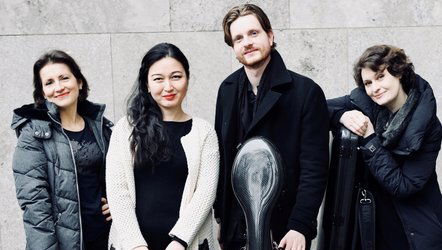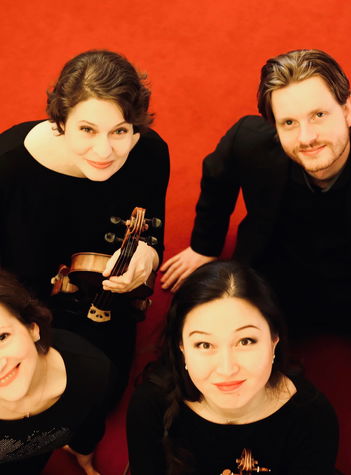Programme
Petr Popelka
Synthesis ad lib.
Esa-Pekka Salonen
Homunculus
Ástor Piazzolla
Tango Ballet
— Intermission —
Antonín Dvořák
String Quintet No. 2 in G major, Op. 77
Secure your seat for the 2025/2026 season – presales are open.
Choose SubscriptionThis season’s Czech Chamber Music Society curator Petr Popelka dons another of his many musical hats for this programme: playing the double bass, the instrument with which he began his career. For his final curated concert this year, he joins the Elphier Quartett for Dvořák’s String Quintet No. 2. The rest of the programme is devoted to newer music including a work by Astor Piazzolla, the legendary king of tango.
Subscription series II | Czech Chamber Music Society
Petr Popelka
Synthesis ad lib.
Esa-Pekka Salonen
Homunculus
Ástor Piazzolla
Tango Ballet
— Intermission —
Antonín Dvořák
String Quintet No. 2 in G major, Op. 77
Elphier Quartett
members of the NDR Elbphilharmonie Orchestra
Lyudmila Minnibaeva violin
Yihua Jin-Mengel violin
Alla Rutter viola
Phillip Wentrup cello
Petr Popelka double bass

Elphier Quartett

The Elphier Quartet was founded in 2016 in Hamburg. Each of the four musicians comes from a different cultural background. What they have in common apart from many other things is they are all members of the NDR Elbphilharmonic Orchestra. The name Elphier Quartet therefore is a play on words which refers to their orchestral lineage and the nickname of the concert hall (=Elphi) on the one side and to the number of members (Vier = Four) on the other side.
Having often played the so called core repertoire of string quartet literature, the Elphier Quartet focuses on the performance of until today seldom played works from classical, romantic as well as contemporary composers. Most recently the Elphier Quartet worked together with the very well-known composer and conductor Esa-Pekka Salonen on his piece Homunculus which they performed in February 2023 in the Great Hall of the Elbphilharmonie. Another essential project in 2023 included the premiere of a new work Synthesis ad lib. written by rising conductor and composer Petr Popelka.
On a regular basis the Quartet is joined by an internationally celebrated pianist Anna Vinnitskaya, with whom the ensemble amongst other pieces performed the piano quintet by Mieczyslaw Weinberg in 2022, and highly respected pianist Haiou Zhang, with whom they hold an intense musical friendship reflected in various concerts and festival performances.
As prize winners of many national as well as international competitions, the members of Elphier Quartet have already worked for numerous broadcasting companies and TV productions, playing at various festivals around the globe as well.
Petr Popelka double bass
In the course of just a few seasons, Petr Popelka has established himself as one of the most inspirational young Czech conductors as he enters the 2024/2025 season in his first year as chief conductor of the Vienna Symphony Orchestra. However, Popelka’s engagement in this challenging position (after several years working with the Norwegian Radio Orchestra) does not hinder him from performing other conducting duties in this country as well; he continues to hold the position of chief conductor and artistic director of the Prague Radio Symphony Orchestra. Besides performing in concerts, he has also devoted himself to opera, having worked, for example, at the Norwegian National Opera in Oslo, at the Semperoper in Dresden, and at Prague’s National Theatre.
However, it was as a double bass player that Popelka got his start. He first studied the instrument in Prague, then in Freiburg, and having finished his studies, he was hired by the Staatskapelle Dresden, where he worked for nearly ten years as the deputy principal double bassist. Despite his stellar conducting career, he can be heard on stage from time to time in chamber music both as a double bass player and as a pianist.
Petr Popelka
Synthesis ad lib.
Petr Popelka at first studied the double bass at the Prague Conservatory and then at the Hochschule für Musik in Freiburg, Germany. He was a double bassist of the Sächsische Staatskapelle Dresden, but at the same time began to devote himself to conducting and composition. In 2015 Popelka was the composer-in-residence at the Podium Festival in Mödling, Austria, where he conducted his own composition Labyrinth of the Heart. He served as chief conductor of the Norwegian Radio Orchestra (2020–2023), and now holds the same position with the Prague Radio Symphony Orchestra and the Vienna Symphony Orchestra.
Popelka composes chamber music, often scored for the double bass, using innovative elements of style creating new timbres of individual instruments, such as Scenes for Piano Quartet (2015) and Four Nocturnes (Vier Nachtstücke) for clarinet and piano (2016). His Synthesis ad lib., to be heard tonight, has been written for the Elphier Quartett, which premiered it on 1 May 2023 in Hamburg.
Esa-Pekka Salonen
Homunculus
Esa-Pekka Salonen was born in Helsinki. He is currently the music director of the San Francisco Symphony; prior to that he was the principal conductor and artistic advisor of the Philharmonia Orchestra in London and artistic director of the Baltic Sea Festival. He studied composition at the Sibelius Academy in Helsinki and is best known for his work with the Los Angeles Philharmonic. For this orchestra he composed L.A. Variations (1996) as well as other opuses, including Concerto for Alto Saxophone and Orchestra (1980), and Floof for Soprano and Five Players (1982).
Homunculus is a string quartet in one movement, written by Salonen during 2007 for the Johannes Quartet. The music, initially dramatic and pulsating, changes in its mood, slipping into nostalgia and featuring a static chorale. Salonen was inspired by the Baroque theory of conception, as he explains: “I wanted to compose a piece that would be very compact in form and duration, but still contain many different characters and textures. The title of the piece refers to the arcane spermists’ theory, who held the belief that the sperm was in fact a ‘little man’ (homunculus) that was placed inside a woman for growth into a child. This seemed to them to neatly explain many of the mysteries of conception. I decided to call my piece Homunculus despite the obvious weaknesses of the 17th century theory, as my goal was to write a small scale piece that would nevertheless contain all the elements of a ‘fully grown’ string quartet.”
Ástor Piazzolla
Tango Ballet
The following piece offers an original artistic stylization of the urban folklore that came into being at the end of the 19th century. The Argentine Tango was forged from a range of musical influences. As defined in one music guide, “It was a definitively urban music: a product of the melting pot of European immigrants, criollos [Creoles], blacks and natives, drawn together when the city became the capital of Argentina in 1880.”
Tango Ballet is the work of Argentina’s most famous composer, arranger and bandoneon player, Ástor Piazzolla. It is a typically jazzy and rhythmically original composition in keeping with the Nuevo Tango style. Within this style, the composer has managed to incorporate the tango into the “higher” classical musical forms while preserving the ethos of the culture of his native country. Tango Ballet was originally composed in 1956 for Piazzolla’s band Octeto Buenos Aires, consisting of two bandoneons, two violins, double bass, piano, cello and electric guitar, to be followed by versions for orchestra and string quartet later.
Antonín Dvořák
String Quintet No. 2 in G major, Op. 77
The string quintet scored for two violins, viola, cello and double bass (or two cellos) has been one of the basic genres of chamber classical music since the 18th century. This form, in addition to the string quartet and piano quintet, was developed in three of the opuses by Antonín Dvořák, still the most performed Czech composer, who belongs to the representatives of the Classical-Romantic synthesis alongside Brahms, Tchaikovsky and Franck.
Dvořák wrote String Quintet No. 2 in G major, Op. 77 in 1875, and under the motto “For my nation” he entered it for a competition held by the music section of the artists’ association Umělecká beseda, ultimately winning the competition. At first, his quintet was in five movements, which Dvořák later reconsidered and removed the Intermezzo; this more traditional version in four movements was subsequently published by Fritz Simrock in 1888 as Opus 77. It is Dvořák’s only string quintet with double bass, and as such it is regarded to be a proof of his idiosyncratic style and extremely prolific creative period in the 1870s. It comprises not only a wealth of original melodic ideas with distinctive rhythms and heartfelt lyricism, but it also represents a balanced form impressively employing the sound of all five instruments.
This season’s Czech Chamber Music Society curator Petr Popelka dons another of his many musical hats for this programme: playing the double bass, the instrument with which he began his career. For his final curated concert this year, he joins the Elphier Quartett for Dvořák’s String Quintet No. 2. The rest of the programme is devoted to newer music including a work by Astor Piazzolla, the legendary king of tango.